2010 Civil War Travelogue
Welcome to my 2010 Travelogue page, Part 4. Go to Part 1. Go to Part 2. Go to Part 3.
| Here is a reminder about the reason I write these pages the way I do. They record my experiences and impressions of Civil War trips primarily for my future use. Thus, they sometimes make assumptions about things I already know and focus on insights that I receive. They are not general-purpose descriptions for people unfamiliar with the Civil War, although I do link to various Wikipedia articles throughout. Apologies about the quality of interior photographs—I don't take fancy cameras with big flashes to these events. If you would like to be notified of new travelogues, connect to me via Facebook. |
Military Vehicle Technology Foundation, October 23
This is not a Civil War trip, but I think some of the readers of my travelogues might be interested in a more modern military experience with tanks and other armored fighting vehicles. See my report.
Trip to DC & Virginia, October 28 – November 7
I took a lengthy trip back east to in conjunction with the Marine Corps Marathon, for which I have trained the last four months with Team in Training. Read my log of running training, if you're interested in that, or my description of the race. But while I'm here, I was able to fit in a number of Civil War visits and activities.
Thursday, October 28: to DC
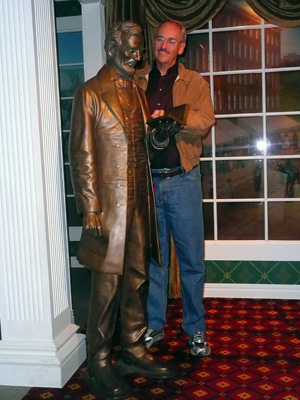 |
| Hal and little guy at Ford's Theatre (see Monday below) |
Nancy and I flew from SFO to IAD (Dulles) on United and checked into the Palomar Hotel on P Street, near Dupont Circle. I selected this hotel because it offered a package for marathon runners and I like the area. It's a great boutique hotel, part of the Kimpton chain. Dinner at Pizzeria Paradiso, also on P, which I'd recommend for both the pizzas and the huge beer list.
Friday: DC
We spent a good part of the morning at the race Expo at the Washington Convention Center, picking up my racing bib, T-shirt, and goodie bag. It was great to see so many young Marines running the place. I expected DC to be pretty deserted with everyone gone for the election, but it was quite busy and the Metro was packed all day. The weather is beautiful, perfect for racing.
After lunch we went to the National Portrait Gallery in the old Patent Office building. The last time I visited it was simply portraits, but now they've incorporated the Smithsonian Museum of American Art to share the very large space. I think this is my favorite art museum in the US because I just love the personal connections to the great men and women of American history. They have all the presidents from GW to GWB (and W's new informal portrait is superbly painted, as real as a photograph), all the big generals and admirals from WWII, and an excellent collection of Civil War portraits. In the CW area, there is also a collection of Winslow Homer engravings that appeared in Harpers Weekly. Some of the most interesting (to me) portraits are below. All were taken with my iPhone 4! I find that for low-light conditions, it does a better job in "HDR" mode than my Panasonic camera, although the results at full size are rather "noisy."
Two special exhibitions were open that did not allow photography. A large collection of B&W photos by Alfred Wetheimer of Elvis Presley on tour at age 21 were fascinating. And a special show of Norman Rockwell works that are owned by Steven Spielberg and George Lucas was really great. What an artist he was, fabulous realistic technique with heartfelt scenes of real Americana.
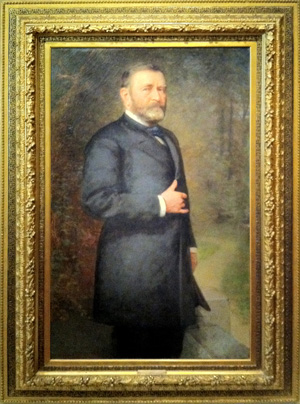 |
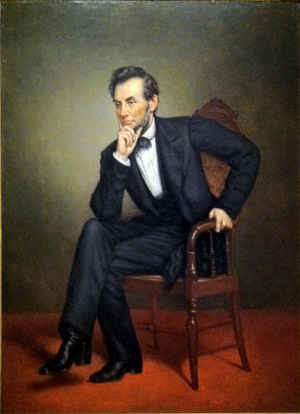 |
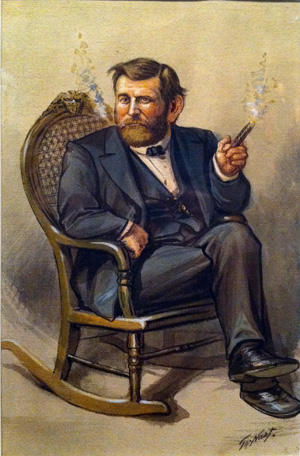 |
| Grant after his presidency and world tour | Guess Who? | Grant by Ogden Nash |
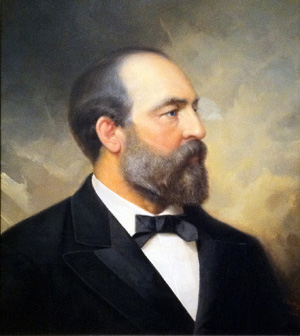 |
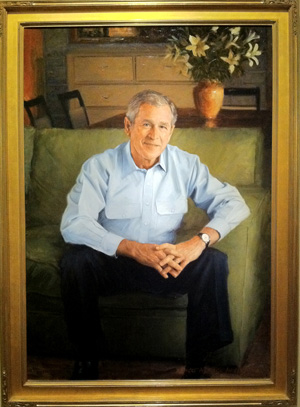 |
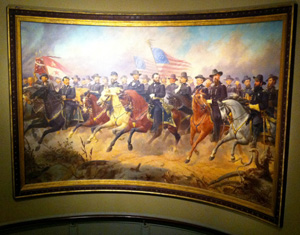 |
| James A. Garfield | Miss him yet? | Grant and his Generals (difficult to photograph well) |
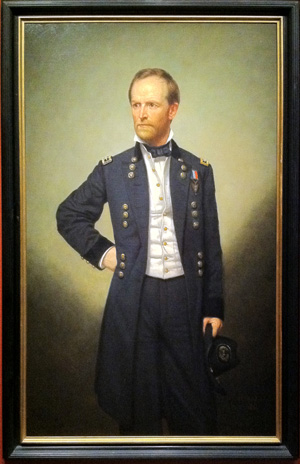 |
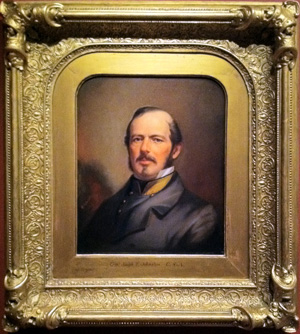 |
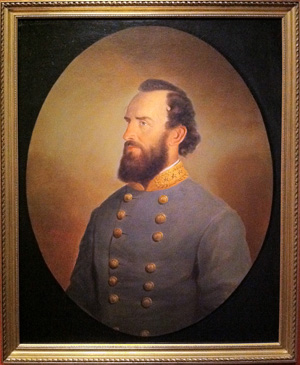 |
| William T. Sherman | Unusual view of Joseph E. Johnston | Stonewall Jackson |
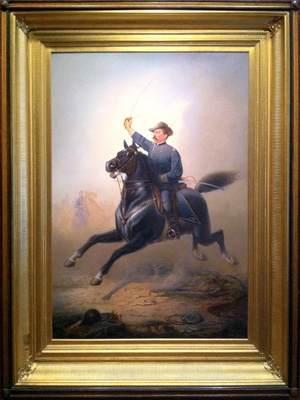 |
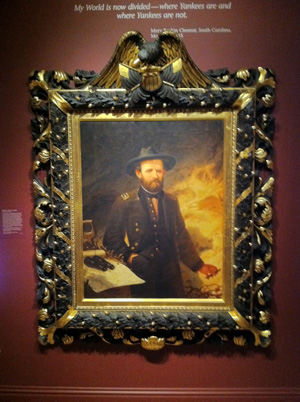 |
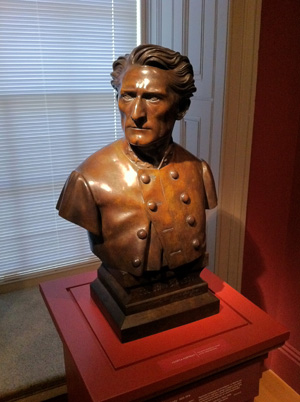 |
| Phil Sheridan on Rienzi | A portrait of Grant I don't recall seeing before | John S. Mosby |
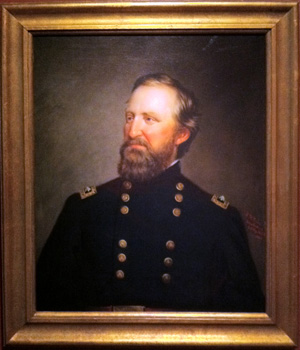 |
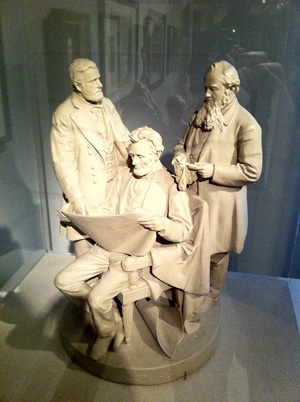 |
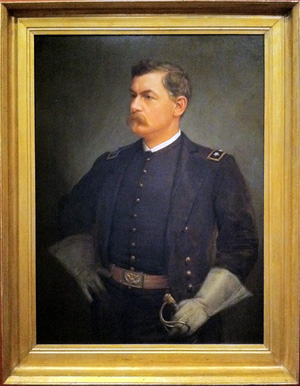 |
| William S. Rosecrans | Grant, Lincoln, Stanton (about 15 inches) | George B. McClellan |
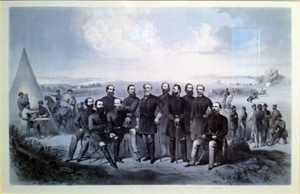 |
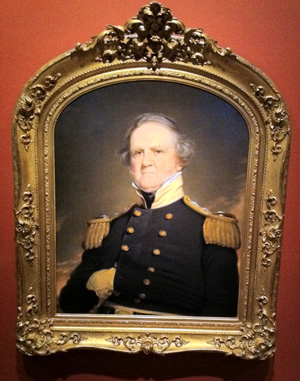 |
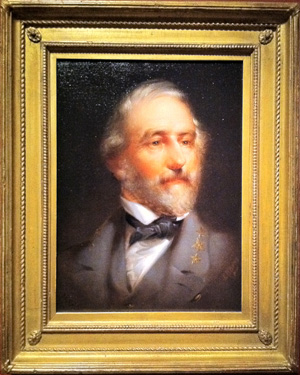 |
| Lee and his generals | Winfield Scott | Unusual portrait of Robert E. Lee |
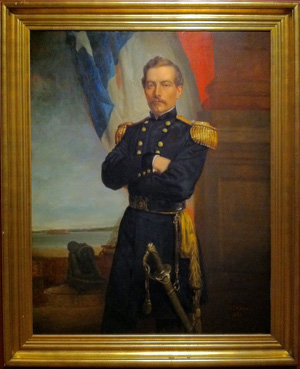 |
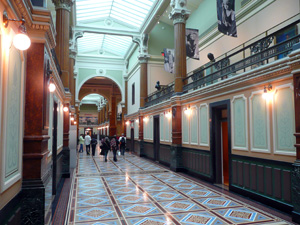 |
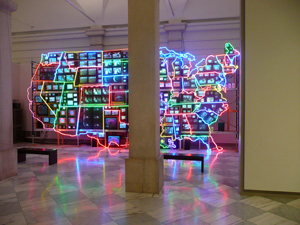 |
| P.G.T. Beauregard | This was once the largest room in America | An interesting modern work; each state has TV images appropriate to that state |
Saturday: DC seminar
Today was a seminar, Passage to War, arranged by the Blue and Gray Education Society (BGES) in Navy Memorial Hall.
The Constitutionality of Secession by Stephen Vladeck, Professor of Law, American University. This was my favorite presentation of the day. I find constitutional law to be fascinating because it combines my love of history with current day politics. In this case, the right of states to secede from the Union is only of marginal interest to most modern people, but it is the core issue of the Civil War and one in which students of the war still argue incessantly. Prof. Vladeck was very well spoken and presented a well organized case about the legality, rather than the morality, of secession. Unlike the Declaration of Independence and the Articles of Confederation, which were leagues of independent states, somewhat like treaties, he described the Constitution as the world's largest corporate merger. The Preamble and article VII make it clear that a state joining the Union becomes a "building block" of the federal nation, losing its ability to act in a fully sovereign manner. The constitutional convention was actually an act of secession from the Articles of Confederation. The Constitution became effective after 11 states had ratified it (nine were required), so for a brief period the rest of the nation seceded from Rhode Island and North Carolina, which were briefly sovereign states until they chose to ratify it themselves. He said that none of the state ratification actions came with any conditions that might be used to justify a rationale for secession in the future. In answer to a question that I posed, he admitted that the Supreme Court decision Texas versus White is still current, but he called the method of reaching its conclusion "flawed" and said that legal scholars pay little attention to it today.
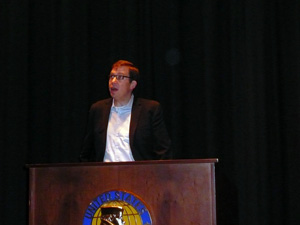 |
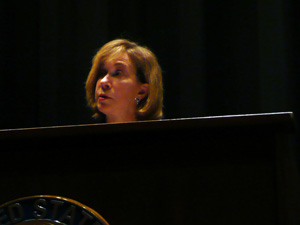 |
| Stephen Vladek | Elizabeth Brown Pryor |
State or Country, The Hard Choices of 1861 by Elizabeth Brown Pryor, winner of the 2008 Lincoln Prize for Reading the Man: A Portrait of Robert E. Lee through his Private Letters. This was also an entertaining presentation in which Pryor got us to think about the issues of supporting the Union versus your own state. She focused initially on Robert E. Lee's decision, deriding those historians who considered it to be a "no-brainer." She called his decision Shakespearean. She clarified that the federal position Lee rejected was command of the defenses of Washington, not all federal forces, which were to be retained by Winfield Scott. In 1861, Lee did not find a constitutional right to secede and his father, Light Horse Harry Lee, was a Federalist. The second half of her presentation was a discussion in which she presented family background information about individuals and we attempted to discover who the people were and guess which side they ended up supporting. The first was the Magruder family, the second her own ancestors. One interesting tidbit I learned was that the Navy issued dishonorable discharges to those officers who left for the Southern service, unlike the Army.
A Project of Much Significance, Digitizing the Papers of the Lincoln Administration by Karen Needles with Len Riedel. Needles is working primarily on her own with a small group of volunteers to digitize all of the papers and putting them online for subscription. Their website is www.lincolnarchives.us. I was amazed to hear that the Library of Congress provides no index or catalogue for these documents. They are sorted into boxes that can contain as many as 500 documents each and they periodically move documents to other boxes when it becomes convenient. It takes about 30 minutes to scan and transcribe a handwritten document and put it into their database. Of the roughly 11,000,000 documents available, about 4% have been scanned, and not all of these are online yet. BGES has been providing funding to keep the project's servers on the air.
The Abolitionists, Fomenters of Discontent and Beacons of Morality by Michael Chesson, Founding Professor and Dean, The American College of History and Legal Studies. Chesson has founded an unusual university that offers courses only in history and legal studies. His presentation was meant to rile up the audience, confirming the war was not about racial equality, and focused on the hypocrisy of the northern states about their attitudes toward suffrage, interracial marriage, integration of schools, etc. He described the abolitionists as self righteous and pious.
 |
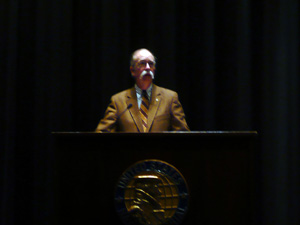 |
| Karen Needles | Russell McClintock |
Lincoln and the Decision for War by Russell McClintock, Ph.D. St. John's High School, author of the book by the same name. McClintock reviewed the key events associated with the Fort Sumter crisis. He said that Abraham Lincoln had a key role in the failure of the congressional compromise attempts and that he had a misplaced faith in southern unionism. He said that Abraham Lincoln almost cracked under the pressure in his early administration. The job of recruiting members of his administration was overwhelming and he was concerned about whether he should trust some of the southern officers who were playing key roles, such as major Anderson and Winfield Scott. I was amused by McClintock's reference to Scott as being "old as dirt" because, at 74, he is not much older than many of the attendees of such Civil War seminars.
There was a brief panel discussion at the end and I can't say that I found the questions too interesting. A question about whether Lee modeled himself on George Washington revealed an interesting trivial item: in late March 1865, Lee was reading a biography of Winfield Scott.
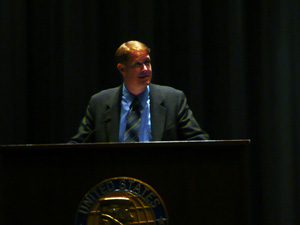 |
 |
| Russell McClintock | Panel: Michael, Russell, Elizabeth, Karen |
Sunday: Marathon
Marathon! Read my report.
Monday: DC, Ford's Theatre and Holocaust Museum
My recovery from the marathon is going pretty nicely. I am still pretty stiff after standing still for a while, but as soon as I walk a few yards I can make reasonable, if slow, progress. To start off the morning, we visited Ford's Theatre, which requires that you get a ticket in advance; it's free, but Ticketmaster charges a fee to process the transaction over the Web. You start with a nice little museum about Lincoln's term as president, which had a number of graphically well-done exhibits. As usual, I am always on the lookout for errors in other people's work and I was able to find a few here, to my surprise. They described Ambrose Burnside, when he was elevated to command the Army of the Potomac, as a division commander—he was a corps commander (and he actually was an informal wing commander with two corps). They denigrated Winfield Scott as being 80 years old in 1861—in fact, he was 74. (For someone who is almost 61 himself, this sort of thing matters a bit.) In discussions about Lincoln and his generals, they essentially ignored everything in the Western theater other than Ulysses S. Grant. The theater was being reconfigured for a new play, so the stage was in disarray and the normal ranger talk did not occur, but we did get to peek into the fateful box where are Abe and Mary sat. The Petersen house across the street, where Lincoln died, was being renovated and we could not go in.
 |
 |
| The fateful box at Ford's Theatre |
The box as seen from the stage |
 |
 |
| Nancy at Ford's Theatre | Ditto; stage being set up |
On the way to the Mall, we passed by the White House and admired the William T. Sherman statue. I was amused to see that in the lengthy list of battles at the base, they omitted Pickett's Mill, just as his Memoirs did. Also, they have a bas relief panel depicting Sherman before Missionary Ridge, not one of his successes. Nancy decided to go to the Natural History Museum instead of accompanying me on a walk to the Lincoln Memorial, which is really quite a hike. I read both speeches carved into the walls and listened to some cellphone-based explanations from Park Rangers. On the way I visited the World War II Memorial, and the Vietnam War Memorial on the way back. I was very under-impressed by WWII. It had the look of a committee design.
We had lunch at the museum, amazed at how expensive the government can make food. My question is why they can't use some all-American contractor like McDonald's, which would offer popular menus at half the prices?
Next we walked over to the National Holocaust Museum. There was a lot of background on the rise of the Nazi movement and anti-Semitism. They used excellent graphic techniques to show the progress of the war and the emergence of concentration camps. There was a dramatic walk-through display of a tiny freight car that transported as many as 100 prisoners. Hundreds of photographs from a single village filled a large tower. The decor was stark and industrial, well befitting the gruesome subject. All of it was very chilling, but particularly those exhibits that involved the lack of interest in United States in doing anything about the situation before or during the war, as well as our refusal to deal with the refugee situation. This is a very depressing museum, but very, very effective.
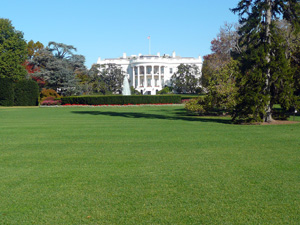 |
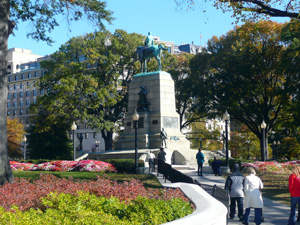 |
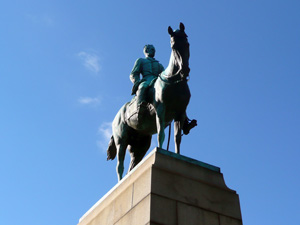 |
| On the way to the Mall | Sherman memorial, right in front of the White House | Sherman closeup |
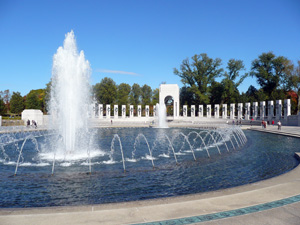 |
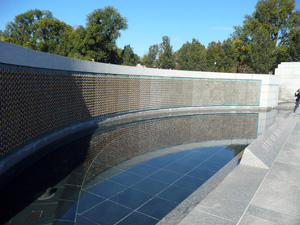 |
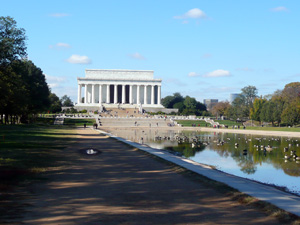 |
| (Half of) World War II Memorial | Each of these stars represents 100 US dead | Lincoln Memorial |
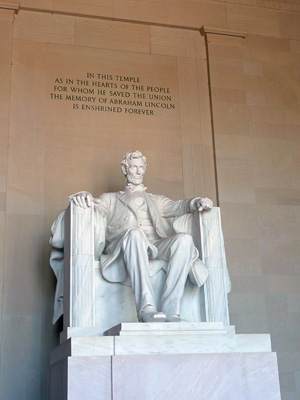 |
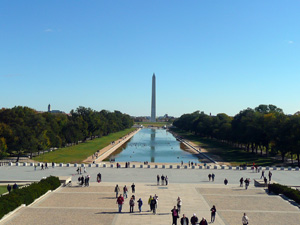 |
| The Great Emancipator | View from Lincoln Memorial |
Tuesday: Winchester
I rented a car from Avis at their downtown location and drove Nancy to Dulles for her return trip to San Francisco. I remained for additional Civil War traveling. I drove to Winchester in the lower Shenandoah Valley, stopping for coffee in my favorite horsey town, Middleburg. I also lingered around Upperville, where a cavalry battle occurred in the Gettysburg campaign, and which is very picturesque. I entered the Valley through Ashby's Gap. I continue to think that the Valley is one of the most beautiful places in the United States. In Winchester I stopped for lunch on the nice little pedestrian mall and visited a bookstore, where I was delighted to find a 1000-piece jigsaw puzzle of the Grant and His Generals painting from the National Portrait Gallery. The owner of the bookshop told me that they have stopped giving out bags for purchases, but that no one in Winchester would be upset about me carrying around a picture of US Grant. :-)
My first stop after lunch was the Cedar Creek Battlefield headquarters and gift shop, which is a tiny house on the Valley Pike in Middletown. The proprietor was decidedly downbeat. I told him I wanted to visit the battlefield he said, "Well, there's not much there. This is a 600 acre battlefield and about 300 are preserved, but most of it is being used by grazing cattle, so you can't go there." He did draw me a small map of how to find the New York monument and a line of Federal entrenchments. Upon further coaxing, he revealed that there was a driving tour that was described in a six dollar booklet, which I purchased and ended up being very happy with. I don't know why he was so reluctant to engage with me—perhaps the bookstore called ahead and told him about the Grant painting in my car. I watched a video for a while that used films of reenactors to describe the battle. It was very well done, but quite lengthy, so I did not stay for the entire film.
I followed his map and took a walk in the woods, finding a handful of wayside signs on a very faint path. The earthworks, constructed by the XIX Corps, are still well defined, although overgrown. The entire area consists of beautiful rolling hills and open fields, but there are a lot of houses on very large lots scattered all over. Massanutten Mountain looms dramatically over the southern end of the battlefield. The driving tour directed me to the "Stonewall Jackson Museum," but when I got there the gate was closed, so I did not see it or the Hupp's Hill fortifications.
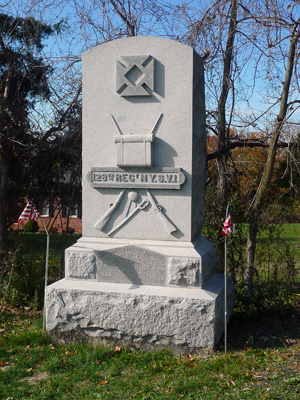 |
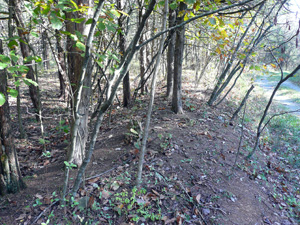 |
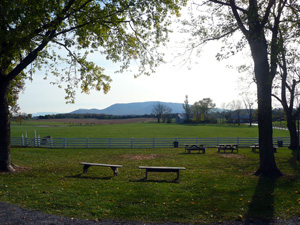 |
| 128th NY | Some XIX Corps earthworks | Massanutten looms |
At the entrance to Belle Grove Manor, an 18th-century plantation and mansion that was used by Phil Sheridan as a headquarters, I photographed the Stephen D. Ramseur monument. Ramseur was one of the best young Confederate generals, killed nearby during the battle. I visited the outside of the mansion, but did not bother going in—the battlefield guy told me I would learn nothing about the battle there. I noticed the quarry nearby has caused quite a fuss in the preservation community. I followed a number of farm roads around the cemetery and marking Jubal Early's final line. I found the position where Sheridan arrived on the battlefield and began to rally his troops.
 |
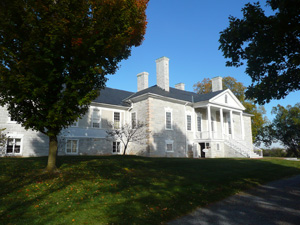 |
| Belle Grove and the Quarry | Belle Grove |
Driving back north to Winchester, I found an interpretive sign on the three defensive forts that played a role in the Second Battle of Winchester, conveniently located in the parking lot of the Virginia Farm Store. I drove to the Star Fort, which is directly next to the Star Fort housing development. The fort is fenced off and a sign says that permission is required to enter, so I only got a view from one side, but it seems very well preserved. A man pulled up in his car and told me not to stand there very long because Stonewall Jackson was moving up the Valley! I laughed, but knew that this fort had not been developed fully during Jackson's Valley Campaign and by the time of the second battle of Winchester, he was dead.
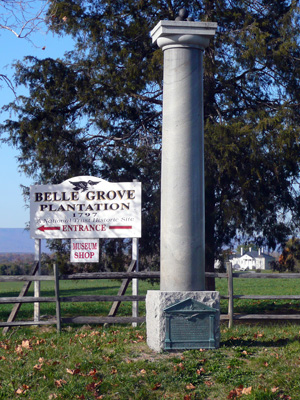 |
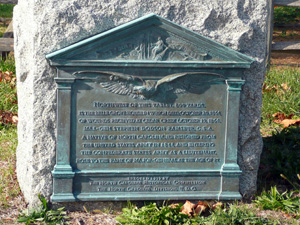 |
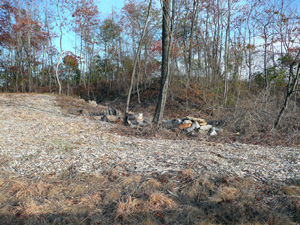 |
| Ramseur monument | Ramseur closeup | Star Fort |
Wednesday: Culpeper
I slept in a bit because I stayed up late Tuesday night watching election returns (and working on this webpage :-)). But I soon hit the road for Stephenson's Depot, a few miles north of Winchester. Although there was an action here in the third battle, the one in the second battle was of more interest because one of my very few Civil War ancestors, Lucian Medbury, was captured by the Confederates along with most of his regiment, the 18th Connecticut. (I don't have a lot of details on Lucian, but I suspect he was exchanged pretty quickly and suffered minimal prison time. He was a corporal at the time and was promoted to sergeant in 1864.) There is not very much to see here, other than a wayside interpretive marker in an area that is essentially flat.
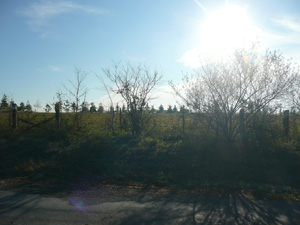 |
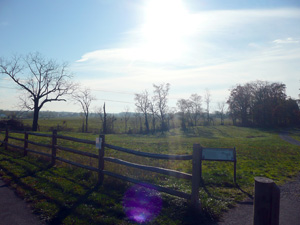 |
| Stephenson's Depot—hill used by Confederate artillery | Stephenson's Depot |
I drove back into town and visited the Old County Courthouse, which is now a Civil War museum. They charge five dollars and you get to see a large collection of Mort Künstler prints and a very large number of artifacts, such as buttons, badges, belt buckles, Minié balls, rifles, and a lot of other things they dug up. They have an impressive collection of artillery shells and naval mines, for some reason. The building was used as a hospital and prison and one of the attractions is seeing some of the graffiti written on the walls. The modern interior walls are about 3 inches on top of the original, so where something interesting was written, they left a hole in the new wall and put in a little window to see through to the original wall. I generally found these pretty difficult to read and they were often simply names. However, the highlight, as identified by the lady at the gift shop, was a rambling "curse" that some Union soldier had scrawled, demonstrating his anger toward Jefferson Davis. The lady made it seem as if this were something naughty, but when I returned to the gift shop I found that they were selling posters and jigsaw puzzles of this curse. The gift shop also had a large collection of used books for sale, which I find rather unusual, but wish it happened more frequently.
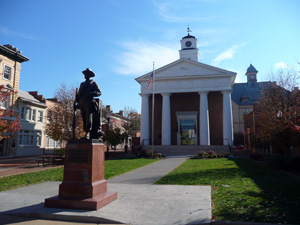 |
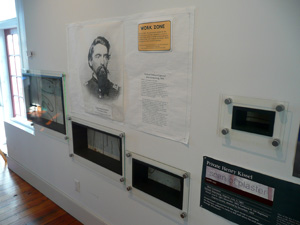 |
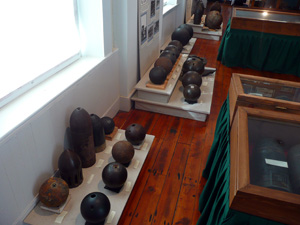 |
| Old County Courthouse Museum | Windows to wall graffiti | Some of the impressive artillery and naval shells |
 |
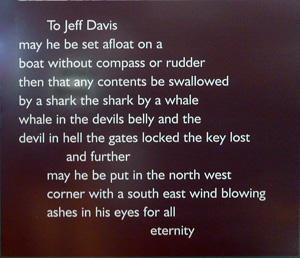 |
| The famous curse (displayed on a poster) | The text of the curse |
My last stop in Winchester was the battlefield of the third battle (known by the NPS as the Battle of Opequon, which is the name of the nearby stream). The CWPT has done a nice job of preserving some key land and I took a lengthy walking course that led down to the Red Bud Run and then up the other side to the Hackwood Farm. There were about a half dozen wayside signs. Winchester is one of those battlefields where the town has been expanding and it is difficult to preserve everything, particularly in this case because there were so many actions all over in multiple battles, but I think the CWPT has done about as well as could be expected.
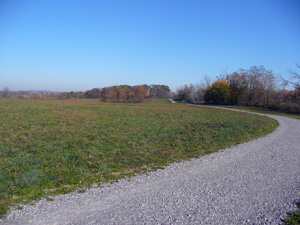 |
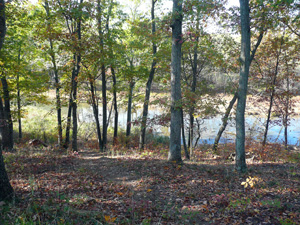 |
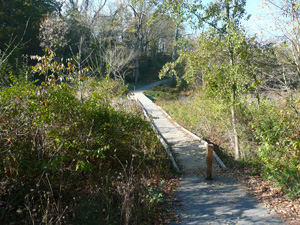 |
| CWPT walking trail at Third Winchester | Red Bud Run | Footbridge |
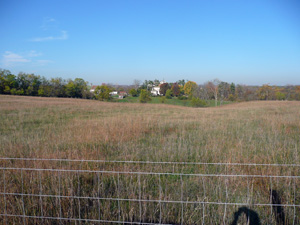 |
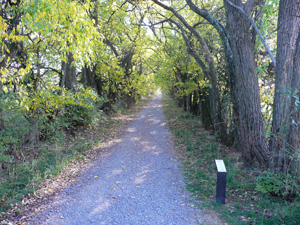 |
| Hackwood house | Hackwood Lane |
The Culpeper area is about a 75 minute drive from Winchester and I enjoyed navigating the quiet country roads, an experience enhanced by the changing fall colors. I stopped in town at the visitor center and picked up a helpful little booklet that provides three driving tours. First I drove a few miles south of town to the Cedar Mountain battlefield. There was one other car in the tiny parking lot and I was amazed at the coincidence of finding Ethan Rafuse visiting at the same time I was. I have enjoyed Ethan's book McClellan's War, as well as a number of journal articles and blog postings. I had only met him once, on a tour to Antietam in 2007, so I was surprised that he greeted me by name! He is currently working on a guidebook of the Second Manassas campaign, which brought him to Cedar Mountain. This battlefield also has a lengthy CWPT walking tour, which I thought was well done. (The CWPT and other preservation organizations need to rethink the materials used for their wayside signs. The plastic covering can get rough and discolored, making the sign difficult to read.) Because this is a completely rural area, it is rather easy to interpret what happened in the battle, even though not all of the land is completely "preserved." There are very few battlefield monuments. Those that are there are tiny stone blocks with unit names carved on top, but I am sorry to say that the weather has made them very difficult to read. One interesting trivial fact I learned was that Cedar Mountain was the only battle in which Stonewall Jackson used his sword, which because of lack of prior use had rusted in its scabbard.
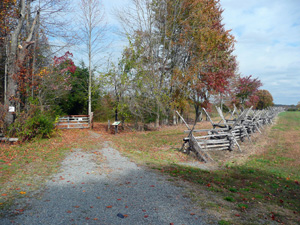 |
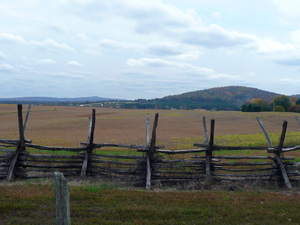 |
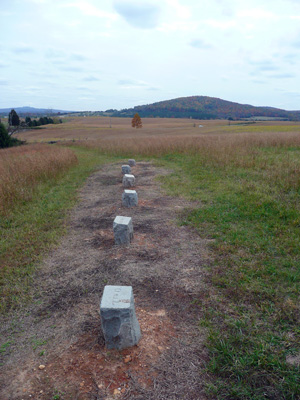 |
| Start of CWPT walking trail at Cedar Mountain | Cedar Mountain; Clark Mountain in the distance | Some of the modest Union markers |
My next excursion was to explore the Battle of Brandy Station. I am embarrassed to say that the last time I came through here I drove to the tiny village of Brandy Station and drove around for quite a while, unable to find anything about the battle. (I guess I was embarrassed enough that I did not even write it in my travelogue for that year because I cannot find the reference.) This time, however, I came armed with the information that I used to create the Wikipedia map of the battle as well as the little guidebook. I started in Stevensburg, one of the approaches of the Union cavalry, and found a small group of wayside signs called Lenn Park, erected by a local family that lost a relative in the battle. Then I stopped at the Graffiti House, which is the information center and gift shop in the village, but it turns out it is not open on most weekdays. Using the guidebook, I found an interpretive sign about the fighting on Fleetwood Hill and then went over to the main preserved area of the battlefield, right next to the tiny Culpeper Airport. Once again, this was a CWPT maintained area with a nice walking trail and wayside signs. It covered the area of the battle near the former St. James Church. The final drive for the day was to Kelly's Ford, the site of a minor battle in 1863 in which Major John Pelham was killed. I found the ford itself, but ran out of time and energy to search out the site of his death.
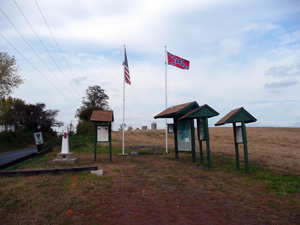 |
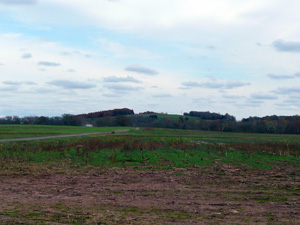 |
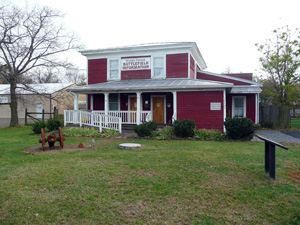 |
| Lenn Park | Coles Hill, the tip of Hansbrough Ridge | Graffiti House |
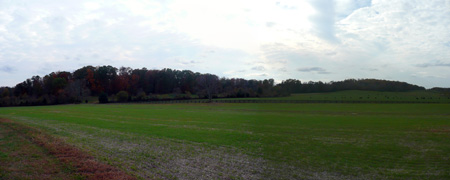 |
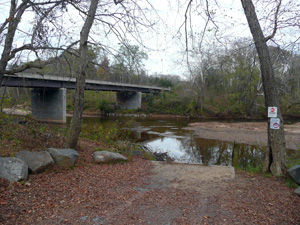 |
| Fleetwood Hill, seen from the St. James Church (CWPT battlefield) area | Kelly's Ford |
Thursday: to Richmond
Today is the first rainy day on my trip, so I had to make some adjustments. I had originally hoped to spend some time searching through the woods for the Mine Run entrenchments, but I have no stomach for wet feet for the rest of the week. So I dawdled at the hotel (the Culpeper Holiday Inn Express, which is very nice), updating this webpage a bit. Then I drove downtown to visit the Culpeper County Museum. They have done a much better job than Winchester and admission was only three dollars. It is not entirely about the Civil War, but about the county from Jurassic times to the present. They have some interesting dinosaur footprints that were dug up recently in a quarry, and some material about the local Indian tribes, but I moved pretty quickly to the 19th century. A.P. Hill is from Culpeper and they have a nice portrait by a local artist. They also have a large three-dimensional map of the county that has light displays illustrating the four battles in the area; in addition to the three I mentioned yesterday, they are also counting a minor skirmish in September 1863 called the Battle of Culpeper Court House. They also showed Union encampments in the winter of 1863-64. I was interested that they claimed Brandy Station saw ten different battles during the war, but they gave no details. They had a set of quiz questions around the map and I found one boner: How many generals in chief did the Union Army have? Their answer included Irvin McDowell and all of the commanders of the Army of the Potomac, plus Grant. (The correct answer is Scott, McClellan, Halleck, and Grant.) I was also amused to see how frequently they danced back and forth between "Civil War" and "War between the States." And of course they were politically correct enough to say the war was fought over "states rights and slavery."
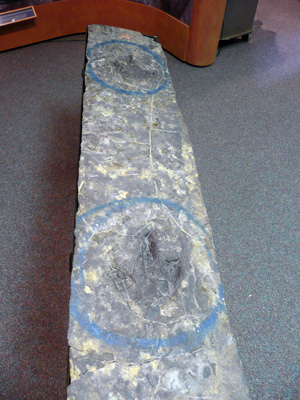 |
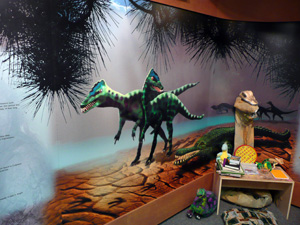 |
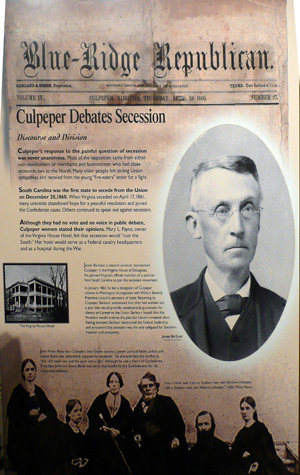 |
| Culpeper dinosaur tracks | Supposedly the kind of dinosaur that left those tracks | I took this photograph because I love the name of the paper |
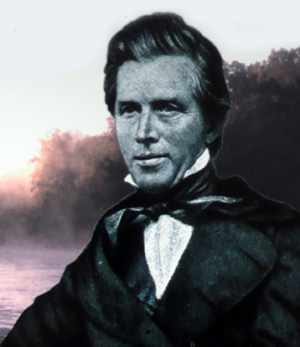 |
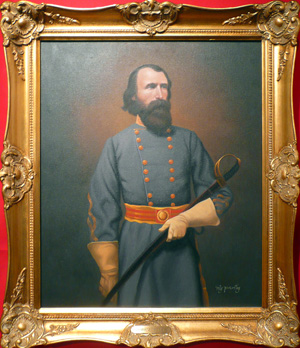 |
| This is a great illustration of Extra Billy Smith as a younger man |
Portrait of A.P. Hill by a local artist |
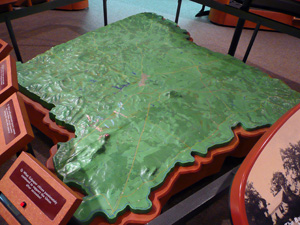 |
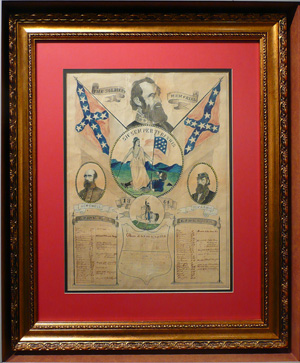 |
| The three-dimensional county map | An interesting illustration from 1864; it features Jackson, Ewell, and Hill |
From Culpeper it was a short drive to the Wilderness of Spotsylvania. I recently wrote a big upgrade of the Wikipedia article, Battle of the Wilderness, and hoped to add some interesting photographs. As I was driving down from Germanna Ford, I was getting pretty hungry and wondered why someone wouldn't put a supercenter there so that I could buy inexpensive provisions. :-) I found that the Lacy mansion, Ellwood, which Gouverneur K. Warren used as his headquarters, was closed and I was not up to speaking through the woods to find it in the rain. But I visited Saunders field and saw some Confederate entrenchments, the Chewning farm, the famous Plank Road and Brock Road intersection, and the place where Longstreet was shot by friendly fire. After that I headed in the direction of Richmond on the Brock Road, passing by Spotsylvania Court House and Massaponnax Church.
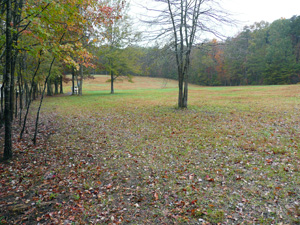 |
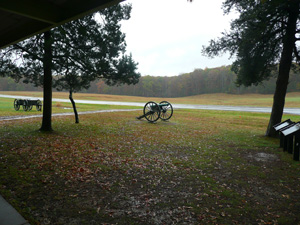 |
| Saunders field in the Wilderness, north of the Orange Turnpike |
Saunders field artillery display; the limber is shown at the correct distance behind the gun |
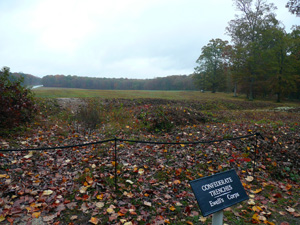 |
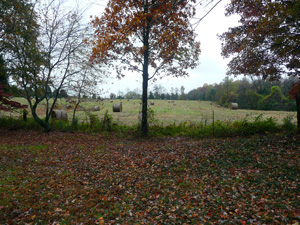 |
| Saunders field south of the Turnpike, showing Confederate trenches | Chewning Farm |
I have already done some pretty extensive touring around Richmond and have seen most of the battle sites, except for Seven Pines (not much left there with the Richmond airport in the way) and Beaver Dam Creek, so I headed to the latter, in Mechanicsville. This was the first significant battle of the Seven Days. There is very little here either, but you can drive to the site of Ellerson's mill, which was at the far right of the Confederate attack, but you can't really see what they were attacking across the creek.
 |
| View of Beaver Dam Creek at Ellerson's Mill |
My final stop for the day was the Jefferson Hotel in downtown Richmond, which is an old, elegant hotel that is very comfortable. The first thing you see as you get out of your car is a full scale bronze alligator, which is the only reminder that the hotel garden used to have alligators in the pool, supposedly brought by guests who had been returning from Florida vacations. They have a nice statue of Thomas Jefferson in the rotunda lobby. They also have a large number of portraits of presidents, mostly from the 19th century. I bet you will be able to guess which president they do not have. They do include Woodrow Wilson as the most recent, but I was not able to find a portrait of Jefferson Davis. Perhaps they thought that two Jeffersons would be too confusing.
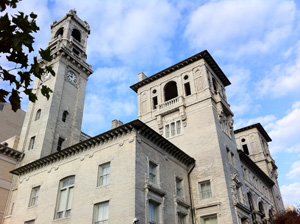 |
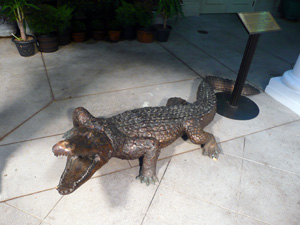 |
| The unusual architecture of the elegant Jefferson Hotel |
Alligator at the Jefferson Hotel entrance |
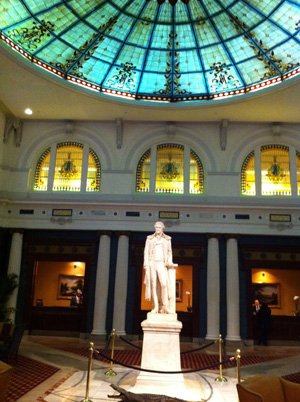 |
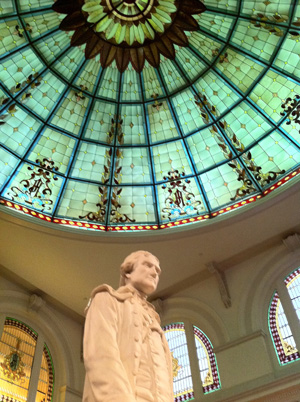 |
| Thomas Jefferson in the rotunda | A closeup |
Jim Lighthizer of the CWPT invited me to dinner! Ben Brand of San Diego joined us. (I guess Jim wanted to get away from East-Coasters for an evening.) We decided to go to a place that I had already selected on Yelp, a modern Southern restaurant called Comfort. I would strongly recommend this restaurant for good, solid cooking in a casual atmosphere, assuming you are in this area of Richmond. (The Jefferson Hotel, as nice as it is, is hardly situated in an area with a lot of night life.) I had a delicious plate of pulled barbecue pork, hoppin' John, and cheddar cheese grits, and finished with banana pudding.
Friday: Richmond, CWPT
Today I am in Richmond by invitation of the Civil War Preservation Trust to attend an "Advanced Guard" weekend, which is a small gathering of people who are active donors who receive information about the organization's plans and strategies as well as some battlefield touring. But the meeting did not start until 1 PM, so in the morning I walked down the street about a mile to the Museum of the Confederacy. I had visited the museum before, in earlier days when I knew less about the war, so I was anxious to see if a return visit would bring me new information. And I will say that I enjoyed myself, although the tiny museum does not have an enormous amount of information on display. They have plans to expand to other cities in Virginia and that will presumably empty out some of their storerooms and allow the display of more artifacts. (At dinner last night we discussed their groundbreaking of a $7 million building at Appomattox and we expressed doubt about how successful that remote location would be in attracting visitors.)
Despite being about the entire Confederacy, the museum is really very Virginia-centric. They brag about the 2,150 military events on Virginia soil and don't mention other states. They say that 350,000 of the war's 1.1 million casualties were in Virginia and that 100,000 men fell within 20 miles of Fredericksburg, more than in the entire state of Tennessee. The museum is on three floors. The floor that you start on is the second, which covers the meat of the battle descriptions and the personal possessions of the famous officers. Rather than describe them in this paragraph, I have written captions to the photographs below. The first floor as an interesting display called the Art of the Confederacy, which has a number of sketches and paintings, mostly by Confederate soldiers. I particularly liked a John S. Mosby portrait by Edward Caledon Bruce of the quartermaster department, a man who could not serve in the Army because he was deaf. The third floor was entitled Between the Battles and it was about camp and civilian life. In the small gift shop I was particularly impressed by a silk tie with portraits of dozens of Confederate generals, savoring how much trouble I would get into at home if Nancy saw it.
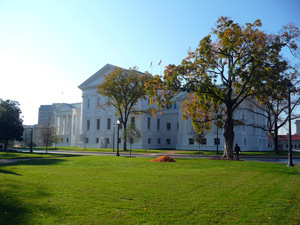 |
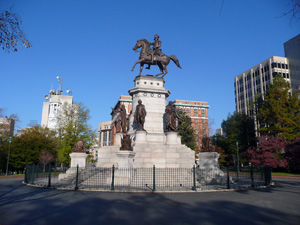 |
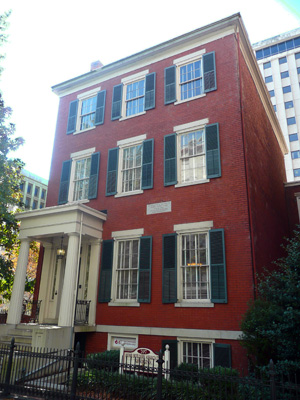 |
| Passing by the state capitol on the way to the Museum of the Confederacy | George Washington and other Virginia figures outside the capitol | A house that Robert E. Lee's family lived in, 1864-65 |
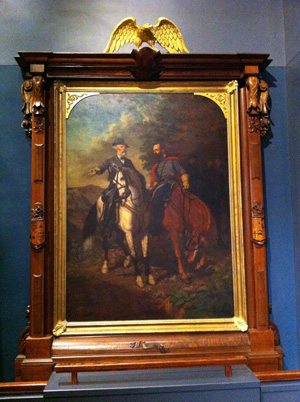 |
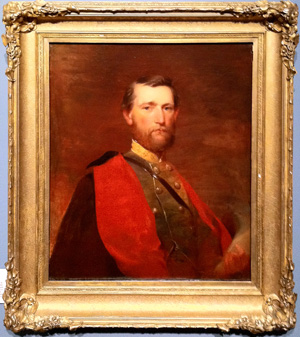 |
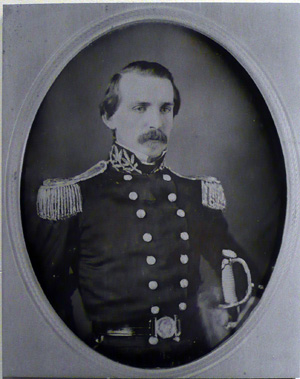 |
| The famous painting of Lee and Jackson at Chancellorsville | John S. Mosby | A rare photograph of A.P. Hill |
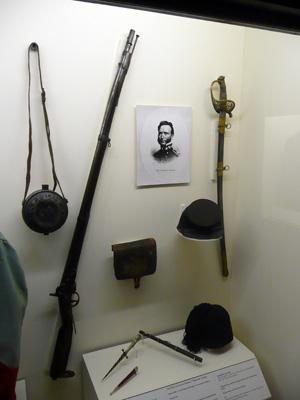 |
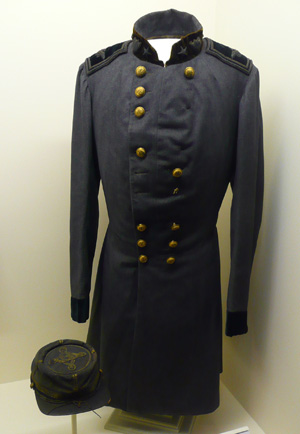 |
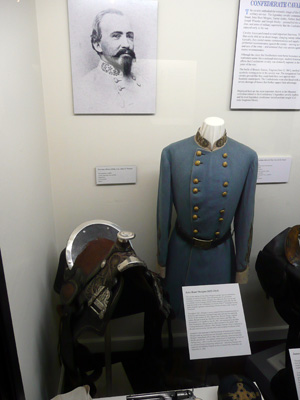 |
| Personal possessions of Stonewall Jackson |
Uniform of Brig. Gen. Simon B. Buckner | Saddle and uniform of John Hunt Morgan |
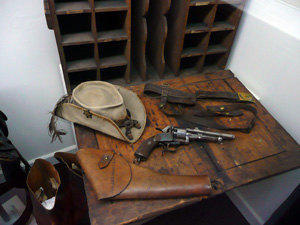 |
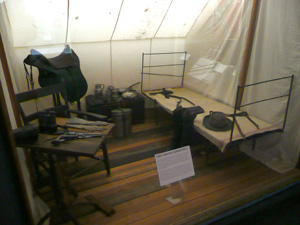 |
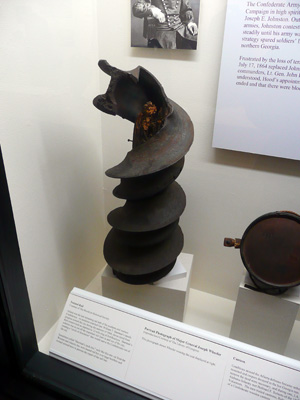 |
| Personal possessions of Jeb Stuart | Robert E. Lee's headquarters tent | A "Sherman's necktie" |
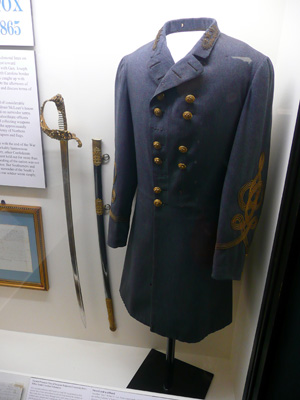 |
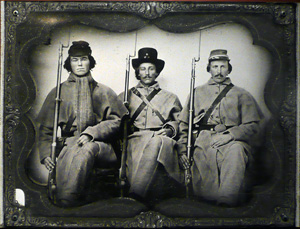 |
| The uniform (with general's insignia) that Robert E. Lee wore to surrender to U.S. Grant | Three "Goober Grabbers" serving in the 3rd Georgia Infantry, Company D. |
After lunch the CWPT started up with opening remarks from Jim Lighthizer and then we immediately got on a bus to travel to Cold Harbor with Gordon Rhea, the preeminent historian of the Overland campaign. I have enjoyed five of Gordon's books for the clarity of his writing, the completeness of his exhaustive campaign studies, and his well reasoned judgments of the generals and their strategies. I had seen him once before, at the Civil War Institute of Gettysburg College, where he gave a bravura presentation without notes about cavalry during the campaign, so he is as good a speaker as a writer. In fact, my entire justification for attending this weekend was to meet Gordon. I had previously signed up for a Blue and Gray Education Society tour of Mine Run, but I checked with Len Riedel and ensured that my absence would not cause his organization financial difficulties by canceling the tour for lack of attendance, and he encouraged me to "go for the better offer." I regretted doing it because Mine Run is an interesting, if obscure, campaign, which I should know more about than I do. Perhaps another opportunity will present itself, such as in the 150th anniversary of the campaign (November/December 2013).
The tour this afternoon was relatively short given the material to be covered and I will have to say that I have been on a more comprehensive tour of Cold Harbor related sites (see my travelogue about Gary Gallagher's University of Virginia seminar in 2006), but Gordon provided excellent information about this portion of the campaign as well as the specific sites. Jim Lighthizer said that Richard McMurry has criticized Gordon for having "Virginia Disease" (VD), which means that he does not ascribe adequate importance to the Western theater, but Gordon was able to demonstrate to us why this campaign was so important to ending the war. He thought it was important to emphasize that Grant deliberately kept moving around Lee's right flank because his supply lines was not over the railroads, but via the coastline. Grant had three focuses for the campaign: (1) conduct a continuous campaign, not one interrupted after each major battle as had been done in the past; (2) target the enemy army, not specific geographic locations; (3) conduct coordinated assaults by multiple armies, not allowing any of the Confederate armies to reinforce each other, as they did in, say, Chickamauga. I was amused by one of Gordon's comments in describing George G. Meade, who he called the victor of Gettysburg, "if there was one." He described Lee's conduct at the beginning of the Battle of the Wilderness to be that of a "terrier going after a bulldog."
Gordon was asked about his writing plans and whether he would publish a fifth book about the campaign, one describing Grant's movement across the James River toward Petersburg. He said that he has finished the draft of the book, but he needed about four months of quiet to collect his thoughts and evaluate his work, which is something he has not been able to do because of the pressures of his real job, being an attorney. So he had no projected publication date to share with us.
We drove northeast of Richmond and traveled over Studley Road (which he claimed that Bobby Krick said was named after himself) stopping first at the Shelton House, built in the 1720s. Prior to the Civil War, it was famous because it was the supposed location of the wedding of Patrick Henry to Sarah Shelton. (As I described in my previous travelogue, the wags at the National Park Service say that it was here he spoke his famous quote, "Give me liberty or give me death.") Gordon thought that this building would be turned into the new headquarters for the Cold Harbor battlefield, which seemed like a stretch to me because it is located rather far from the preserved parts of the actual field. The next day we ran into Bobby Krick and he said that that is not the plan. It was in this area on May 30, 1864, that Hancock's corps (Barlow's division) fought the Confederates near Totopotomoy Creek (which Gordon says is pronounced locally "tuh-POT-oh-mee").
We drove a short distance to the Polegreen Church, which has some religious significance as an early "dissenter church." There we saw some of the earthworks for Jubal Early's Corps (Early having replaced Ewell after Spotsylvania Court House) and discussed how Grant was testing the Confederate line on May 30-31. The Battle of Totopotomoy Creek was a Confederate defeat, one of their few defeats in the entire Overland campaign, and it gave Grant some of the confidence he needed to launch his aggressive assault at Cold Harbor on June 3. The original church was destroyed by artillery and the Park Service has memorialized it with a very interesting steel framework, showing only the bare outlines of the original building. Gordon told us an interesting story about two women who dated A.P. Hill, only to have them end up marrying Union generals—Gouverneur K. Warren and George B. McClellan.
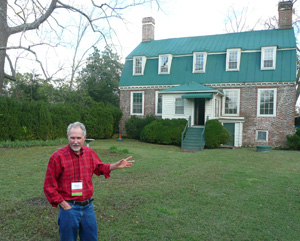 |
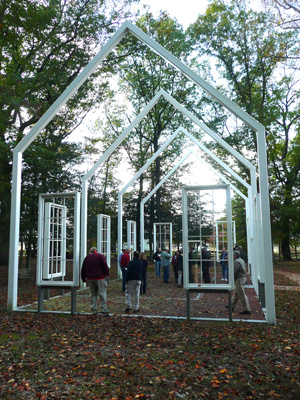 |
| Gordon Rhea at the Shelton House | The monument to Polegreen Church |
We stopped at the Cold Harbor Visitor Center, which is a tiny building that is located near the center of the action for the assaults on June 1, as well as part of the larger June 3 action. We had time for a brief discussion of the battle and the inevitable questions about the high casualties were raised. The conventional wisdom from many works is that from 7,000 to 10,000 casualties occurred in only the first 20 minutes, but Gordon opined that that was based on original accounts from Evander Law's Alabama Brigade. They were at a point in the line in which casualties were very heavy and apparently some authors have extrapolated their observations. He said that his exhaustive research on regimental casualty returns demonstrates that there were about 3,500 casualties in the main assault (and about 12,000 Union casualties for the entire day all across the line). He said that he had the opportunity to discuss Grant's strategy with a number of modern generals and many of them agreed that his approach was generally sound—he had a nontrivial possibility of breaking through the line and crushing Lee's army, whose back was to the river, so it was a chance worth taking. Unfortunately, the attack fell apart at the operational level. Gordon referred to Grant as being reasonable, not a butcher.
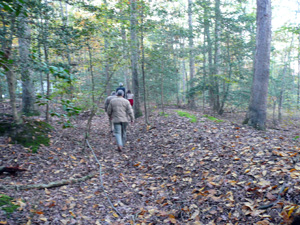 |
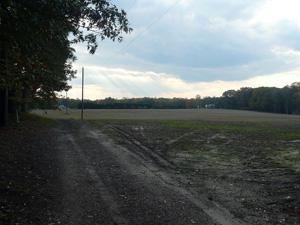 |
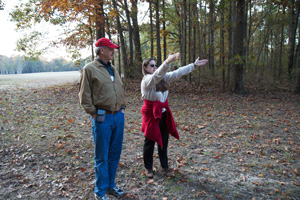 |
| Earthworks on the recently acquired land at Cold Harbor | A view of the Allison farm (land not acquired) | Hal with Julie Krick, photo courtesy of Rob Shenk |
We rode in the bus through the NPS preserved area, seeing the well preserved remnants of the Confederate and Union trenches. It is interesting that there are only two monuments on the battlefield, one to the 2nd Connecticut Heavy Artillery, the other to the 36th Wisconsin. We then drove to the vicinity of Beulah Church, where we met Julie Krick (Bobby's wife), the president of the local preservation group that has just procured some key land in this area over which the XVIII Corps (Baldy Smith) attacked. We walked through the woods and through the earthworks, for which no signs have yet been erected to warn against the practice. This was ground I had walked on before with the Gallagher seminar, next to the Allison farm, I believe, but that was by special arrangement and it was good to see that this private land is now preserved.
After we returned to the hotel we dressed up in coat and tie for a visit to the Commonwealth Club just down the street. This is one of those exclusive private clubs and one of the members was able to arrange to have dinner for us. Cell phones were not allowed, so I felt almost naked without my Internet connection at dinner. :-) Afterward we had a remarkable slideshow presented by Beverly M. ("Bo") Dubose III of Atlanta, who reviewed his lifelong hobby of collecting battlefield artifacts and then went into an encyclopedic explanation of just about every firearm used during the war. This probably sounds boring, but his talk was fascinating and everyone was amazed at how much information he imparted and how entertaining he was doing it. He surprised us at one point with a photograph of a Confederate spy Belle Boyd, which, since this is a family friendly webpage, I will not describe in detail. :-)
Saturday, November 6: Richmond, CWPT
One might say that the Sesquicentennial starts today, the 150th anniversary of the election of Abraham Lincoln (although others might say that the anniversary of the John Brown raid of Harpers Ferry would be the appropriate point). Anyway, a momentous day in history.
We spent the morning in the hotel in sort of a business meeting, getting Powerpoint presentations from key figures in the CWPT. First was Rob Schenk, who talked about the website strategy. It has really been a success story and everyone who has seen the website is very impressed. Some of the interesting tidbits were that Google gives the CWPT a grant of $10,000 annually for Adwords keyword advertising placements. The CWPT has 55,000 members, but they have been able to collect only 36,000 e-mail addresses. In reviewing a draft of online donations, there was a big spike in October, and Rob revealed that there was a "six-figure donation" received online, using ACH, not a credit card. He discussed the recently released battle app for the iPhone, which allows you to use GPS navigation to view the action at Devil's Den and Little Round Top at Gettysburg. I told him off-line that I have some doubts about the scalability of this effort because this one application is 109 MB! He said that they have plans to produce about 20 different battle applications that are similar.
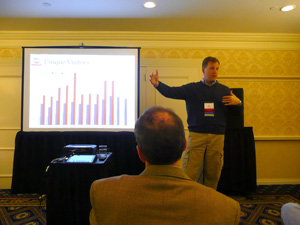 |
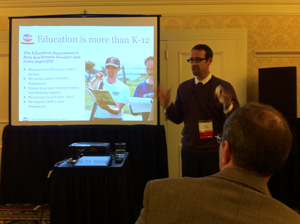 |
| Rob Shenk | Garry Adelman |
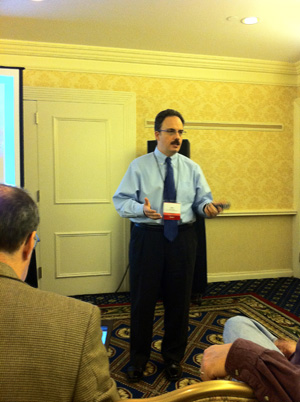 |
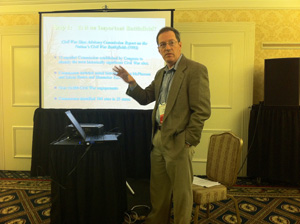 |
| Jim Campi | Tom Gilmore |
Rob used up more than his allotted time, so Garry Adelman had to follow with an abbreviated schedule. Fortunately, Garry can squeeze an enormous amount of material into an infinitesimal time. He talked about the CWPT education strategy, including K-12 lesson plans, teacher seminars, and wayside signs. He mentioned that a big set of wayside signs would be introduced at Payne's Farm (part of Mine Run) in the near future. He handed out old-fashioned cardboard 3-D glasses and we got to view some of his photographs that were originally taken for stereopticons, but the effect was not very good when projected on a standard VGA projector. He also revealed that he is working on a "bucket list" of 150 activities he wants to recommend that people (particularly students, apparently) do during the sesquicentennial—dress up as a reenactor, visit a particular battlefield, etc. I had a talk with Garry offline and he mentioned to me that there is an application for the iPhone that displays the Civil War maps that I did for Wikipedia. I did some investigating and found that the app has been there for about 16 months, but I had never heard of it. The author correctly attributes the maps to me, as the license I use for Wikipedia dictates, but he never bothered to contact me to say he was doing it. The maps are now getting a bit stale because I keep my collection of maps changing with corrections and updates. I decided not to spend the $0.99 it would require for me to download the app onto my iPhone.
Next was Jim Campi, who handles media and government relations. Everyone complimented him on the quality of Hallowed Ground magazine. He talked about the CWPT's 501(c)(4) organization that solicits funds for political activity, which is maintained separately from the primary 501(c)(3) entity. He mentioned that the officers have separate telephones and e-mail addresses when they are working on this subject. One of the key goals is to affect the election of county supervisors in Virginia to ensure that more preservation-friendly people are in office. He talked about the two big campaigns that everyone is concerned about, the Wilderness Wal-Mart and Gettysburg casino. In the former case, it is not simply the Wal-Mart that people are concerned about, but that it would open the door to a lot more development. One family owns 2,000 acres and have talked about creating an "Orange County Tyson's Corner," which would obviously destroy the area. He was optimistic about defeating the casino and said that there are four competing proposals for casinos in Pennsylvania and that only one will be approved. He announced that the next media campaign against the casino would have voiceovers featuring Sam Waterston.
Tom Gilmore is in charge of real estate and he brought us up to date on all of the current and potential acquisitions, making good use of GIS maps in his presentation. Some of the areas coming up for more acquisitions in the near future include Bentonville, Shiloh/Fallen Timbers, Fort Donelson, First Deep Bottom (closely related to Glendale and Malvern Hill), Franklin, Perryville, Wilson's Creek, Chickamauga, and one that is sensitive and confidential, which I will not reveal here, but it is one I have been hoping for for a long time.
After a nice buffet lunch, we got back on the bus and drove to the Glendale battlefield. There, author and historian William J. Miller and property owner Dr. Len Morrow led us through the woods on a two-hour quest to describe the land preservation and the search for a missing roadbed that was crucial in understanding the layout of the battle. I am sorry to say that the battlefield is so forested that it is impossible for me to understand what went on, despite two visits. (I asked Jim Lighthizer about this at dinner and he said that restoring acquired battlefield land is a big priority of his, particularly before the land is given over to the National Park Service, which is often reluctant to cut down trees.)
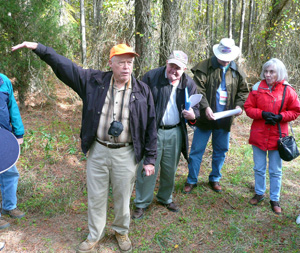 |
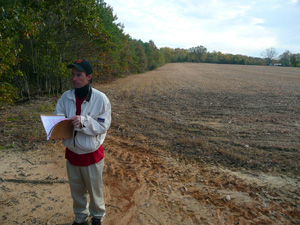 |
| Len Morrow (arm raised) and Bill Miller at Glendale | Bobby Krick at First Deep Bottom; the Enroughty/Darby house is in the distance |
We then drove to the First Deep Bottom battlefield, which was recently expanded by acquiring another 104 acres from a developer who had run out of money to complete a large housing development. There we met up with Bobby Krick, who brought along a busload of Houston Civil War Roundtablers that he was leading through a two-day tour of the Seven Days Battles. Bobby gave an excellent overview of this battle and told an amusing story about how the Enroughty family name came to be pronounced "Darby."
Back at the hotel, we had a cocktail hour and a buffet dinner and the day concluded with a keynote address by Jim Lighthizer, who talked about organizational goals for the next five years. He is proposing a stretch goal of acquiring an additional 20,000 acres during the Sesquicentennial, which would bring the organization's total to 50,000 acres. Since land is averaging $10,000 per acre, this would be $200 million, but because of government grants, it would require $40-60 million to be raised directly by the CWPT. He talked about the difference between retail and wholesale donors, the latter who give $10,000 and more in a single donation, and said that the only realistic way to make those fund-raising goals would be to focus on the wholesale donors. The membership of the organization has been relatively flat over time and although retail donations have been increasing modestly, exponential increases would be required if they were the only ones to be relied upon for this goal. He thought that in order to engage the wholesale donors, he would be required to select 25 to 30 important battlefields and tell them that we would strive to complete the acquisition of sufficient land at those battlefields so that in 100 years, students would be able to fully understand the American Civil War. He said that he had reached out to five prominent historians and asked them to compile such a list and that the first four have responded, with all giving substantially the same answer. He did not reveal the answer. He thought that the ongoing mission of the organization would be to "educate and defend."
Sunday: travel back
I made my travel arrangements before I knew the itinerary for this meeting, so I had to duck out earlier than I wanted to make my flight. Breakfast is scheduled on Sunday for 8 AM, followed by a discussion of membership and development and then a Q&A with the staff, but I will have time only for the breakfast and then I have to hit the road to Dulles, which is almost 2 1/2 hours away. I had excellent time with the CWPT, as usual, and always appreciate the opportunity to mingle with the key players who are doing so much to preserve our battlefield heritage.
My next "trip" is next weekend, but I only have to travel as far as San Francisco, for the West Coast Civil War Roundtable Conference. Visit Part 5 for an update.